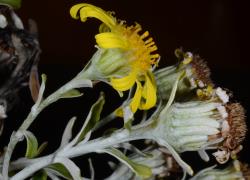- Taxon
- Gallery
- ≡ Senecio monroi Hook.f., Bot. Antarct. Voy. II (Fl. Nov.-Zel.) Part II, 333 (1855)
Much-branched shrub up to 1 m. tall; final branchlets compactly arranged, tomentose, produced into slender peduncles with foliaceous bracts bearing solitary to racemed (rarely > 3) capitula on slender bracted glandular-pubescent pedicels, us. so massed as to produced a pseudo-corymb. Lvs close-set, coriac.; lamina 2–4 cm. × 5–15 mm., narrow- to obovate-oblong, obtuse, narrowed into slender tomentose channelled petiole up to 2 cm. long; margins distinctly crenate and us. waved; glab. brownish green above, below clad in closely appressed white tomentum; midrib us. distinct. Capitula up to 2 cm. diam.; phyll. linear to linear-spathulate, acute, glandular-pubescent on back, inner with scarious tips. Ray-florets 10–15; ligules yellow, broad, spreading to recurved. Achenes 3·5 mm. long, compressed, finely grooved, hispidulous; pappus-hairs slender, up to 6 mm. long, very finely barbellate.
[From: Allan (1961) Flora of New Zealand. Volume 1 as Senecio monroi Hook.f.]
| Category | Number |
|---|---|
| Indigenous (Endemic) | 2 |
| Total | 2 |




